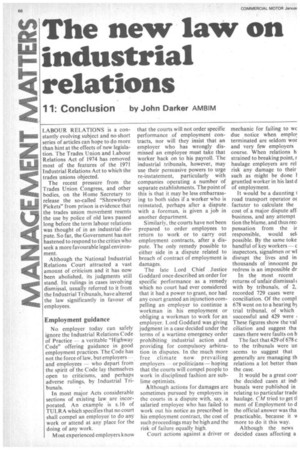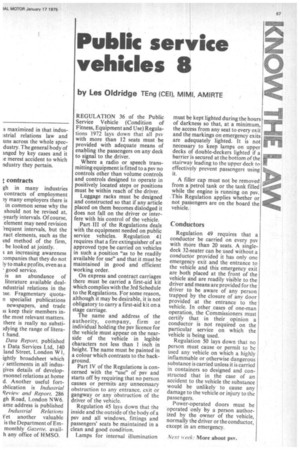The new law on industrial relations
Page 68

Page 69

If you've noticed an error in this article please click here to report it so we can fix it.
11: Conclusion
by John Darker AMBIM LABOUR RELATIONS is a constantly evolving subject and no short series of articles can hope to do more than hint at the effects of new legislation. The Trades Union and Labour Relations Act of 1974 has removed most of the features of the 1971 Industrial Relations Act to which the trades unions objected.
The recent pressure from the Trades Union Congress, and other bodies, on the Home Secretary to release the so-called "Shrewsbury Pickets" from prison is evidence that the trades union moverhent resents the use by police of old laws passed long before the term labour relations was thought of in an industrial dispute. So far, the Government has not hastened to respond to the critics who seek a more favourable legal environment.
Although the National Industrial Relations Court attracted a vast amount of criticism and it has now been abolished, its judgments still stand. Its rulings in cases involving dismissal, usually referred to it from the Industrial Tribunals, have altered the law significantly in favour of employees.
Employment guidance
No employer today can safely ignore the Industrial Relations Code of Practice -a veritable "Highway Code" offering guidance in good employment practices. The Code has not the force of law, but employers and employees — who depart from the spirit of the Code lay themselves open to criticisms, and perhaps adverse rulings, by Industrial Tribunals.
In most major Acts considerable sections of existing law are incorporated. An example is s.16 of TULRA which specifies that no court shall compel an employee to do any work or attend at any place for the doing of any work.
Most experienced employers know that the courts will not order specific performance of employment contracts, nor will they insist that an employer who has wrongly dismissed an employee must take that worker back on to his payroll. The industrial tribunals, however, may use their persuasive powers to urge re-instatement, particularly with companies operating a number of separate establishments. The point of this is that it may be less embarrassing to both sides if a worker who is reinstated, perhaps after a dispute , with a foreman, is given a job in another department.
Similarly, the courts have not been prepared to order employees to return to work or to carry out employment contracts, after a dispute. The only remedy possible to either side in a dispute related to breach of contract of employment is damages.
The late Lord Chief Justice Goddard once described an order for specific performance as a remedy which no court had ever considered that it had a power to grant, nor had any court granted an injunction compelling an employer to continue a workman in his employment or obliging a workman to work for an employer. Lord Goddard was giving judgment in a case decided under the terms of a wartime emergency order prohibiting industrial action and providing for compulsory arbitration in disputes. In the much more free climate now prevailing employers — or politicians — hoping that the courts will compel people to work in disciplined fashion are sublime optimists.
*Ithough actions for damages are sometimes pursued by employers in the courts in a dispute with, say, a salaried employee who has failed to work out his notice as prescribed in his employment contract, the cost of such proceedings may be high and the risk of failure equally high.
Court actions against a driver or mechanic for failing to wr due notice when emplo! terminated are seldom wor and very few employers course. When relations h strained to breaking point, r haulage employers are rel risk any damage to their such as might be done 1 gruntled worker in his last d of employment.
It would be a daunting I road transport operator or factuter to calculate the cost of a major dispute aff business, and any attempt tion the blame, and thus rec, pensation from the ir responsible, would sel. possible. By the same toke handful of key workers c inspectors, signalmen or wl disrupt the lives and in thousands of innocent pa redress is an impossible dr In the most recent returns of unfair dismissal with by tribunals, of 2, recorded 729 cases were conciliation. Of the compl 678 went on to a hearing b3 trial tribunal, of which successful and 429 were These figures show the val ciliation and suggest tha cases there were faults on b The fact that 429 of 678 c to the tribunals were un ,seems to suggest that generally are managing th relations a lot better than the case.
It would be a great con, the decided cases at indi bunals were published in relating to particular trade haulage. CM tried to get ti ment of Employment to d the official answer was tha practicable, because it vi more to do it this way.
Although the news decided cases affecting a s maximized in that induststrial relations law and uns across the whole spee d ustry. The general body of anged by key cases and it e merest accident to which ndustry they pertain.
contracts
gh in many industries contracts of employment )y many employers there is in common sense why the should not be revised at, -yearly intervals. Of course, element may need revision 'requent intervals, but the ract elements, such as the 'lid method of the firm, • be looked at jointly.
s an increasing awareness :ompanies that they do not ly to make pcofits, even as a • good service.
is an abundance of literature available dealndustrial relations in the Ise. Fragmentary quotan specialist publications newspapers, and trade is keep their members inthe most relevant matters. there is really no substi'dying the range of litera t hand.
Data Report, published s Data Services Ltd, 140 land Street, London W ightly broadsheet which settlements in all indusgives details of develop:rsonnel relations at home d. Another useful forttblication is Industrial Review and Report. 286 gh Road, London NW6. ame address is published Industrial Relations Yet another valuable is the Department of Emmonthly Gazette, availh any office of HMSO.
























































































































